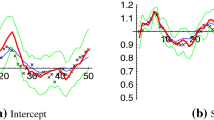Abstract
The Peano-Baker method is applied to the integration of the variational equations to produce the partial derivatives used in satellite navigation. In this method the analytic form of the state transition partial derivatives can be factored so that numerical integration is applied only to the departures from a simplified analytical model.
The advantage of using the Peano-Baker approach rather than direct integration of the variational equations is that with the Peano-Baker method numerical integration can be performed adequately with low order formulae and relatively large step sizes. Numerical results are indicated.
Similar content being viewed by others
References
Battin, R. H.: 1964,Astronautical Guidance, McGraw-Hill, New York, pp. 306–307.
Brouwer, D. and Clemence, G. M.: 1961,Methods of Celestial Mechanics, Academic Press, New York, pp. 176–178.
Danby, J. M. A.: 1962a, ‘Integration of the Equations of Planetary Motion in Rectangular Coordinates’,Astron. J. 67, 287–299.
Danby, J. M. A.: 1962b,Fundamentals of Celestial Mechanics, Macmillan, New York, pp. 235–237.
Danby, J. M. A.: 1964, ‘Matrix Methods in the Calculation and Analysis of Orbits’, and ‘The Matrizant of Keplerian Motion’,AIAA J. 2, 13–19.
Deutsch, R.: 1963,Orbital Dynamics of Space Vehicles, Prentice-Hall, Englewood Cliffs, N.J., pp. 133–134.
Frazer, R. A., Duncan, W. J., and Collar, A. R.: 1963,Elementary Matrices, Cambridge University Press, Cambridge, pp. 217–221.
Gantmacher, F. R.: 1960,The Theory of Matrices, Vol. 2, Chelsea, New York, pp. 125–131.
Goodyear, W.: 1965, ‘Completely General Closed-Form Solution for Coordinates and Partial Derivatives of the Two Body Problem’,Astron. J. 70, 189–192.
Hamming, R. W.: 1962,Numerical Methods for Scientists and Engineers, McGraw-Hill, New York, pp. 206–207.
Ince, E. L.: 1926,Ordinary Differential Equations, Dover, New York, pp. 408–411.
Lee, R. C. K.: 1964,Optimal Estimation, Identification, and Control, The M.I.T. Press, Cambridge, Mass., pp. 142–144.
Myachin, V. F.: 1959, ‘On the Estimation of the Error in the Numerical Integration of Equations in Celestial Mechanics’,Bull. Theoret. Astron. Inst. Nauk. SSSR 7, 257ff.
Pines, S.: 1968, ‘Analytic Approximations to the Solutions of Variational Equations’, N. A. S. A. SP-170.
Riley, J. D., Bennett, M. M., and McCormick, E.: 1967, ‘Numerical Integration of Variational Equations’,Mathematics of Computation 21, 12–17.
Schanzle, A.: 1967, ‘Power Series Representation of Partial Derivatives Required in Orbit Determination’, Final Technical Report for N.A.S.A. Goddard Space Flight Center Contract NAS 5-9756-59.
Sconzo, P.: 1963, ‘Explicit Expressions for the 36 Terms of the Jacobian Matrix used in Orbit Computation’,Mem. Soc. Astron. Italiana 34, No. 2, 1–18.
Sterne, T. E.: 1960,An Introduction to Celestial Mechanics, Interscience, New York, p. 200.
Author information
Authors and Affiliations
Rights and permissions
About this article
Cite this article
Ditto, F.H. Partial derivatives used in trajectory estimation. Celestial Mechanics 1, 130–140 (1969). https://doi.org/10.1007/BF01230638
Received:
Issue Date:
DOI: https://doi.org/10.1007/BF01230638




